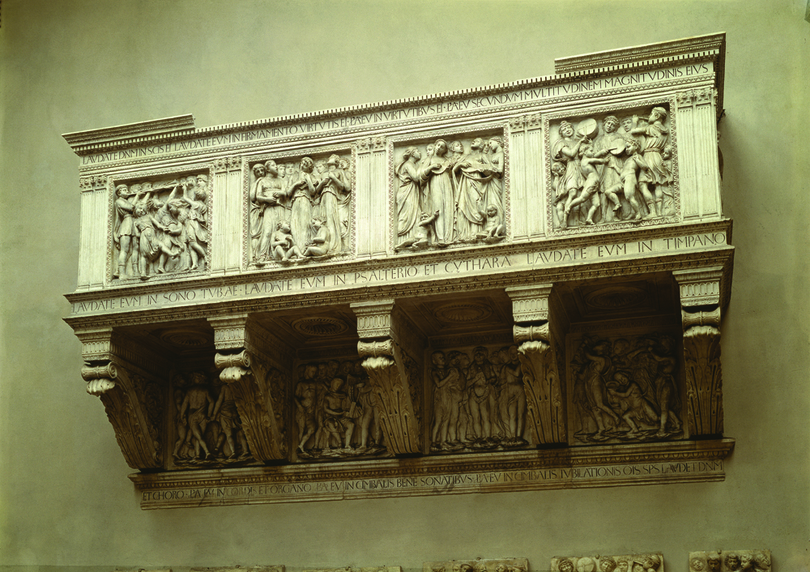Renaissance revival: Professor curates exhibit for art that hasn’t been seen since 1400s
A Syracuse University professor is working to create a both never before seen and never before heard art exhibit, featuring artwork and music from the Italian Renaissance era.
Gary Radke, a humanities professor at Syracuse University, has been working to create a monumental exhibit that will begin this October at the High Museum of Art in Atlanta, Georgia.
Marble panels from the Renaissance, originally created for the Florence Cathedral in 1431, will voyage from across the Atlantic for the first time ever for this exhibit. The “Cantoria” panels are made by Italian Renaissance artist, Luca della Robbia.
“Luca della Robbia’s stunning ‘Cantoria’ was created to be surrounded by music and we are happy to have the opportunity to return the ‘Cantoria’ to that setting,” according to a press release from the High Museum of Art. “We look forward to partnering with the Atlanta Symphony Orchestra to bring our audiences a multisensory experience that celebrates art in its many forms.”
In addition to the panels, the exhibit will also feature choir books from the archives of the Museo dell’Opera del Duomo in Florence as well as the original walnut lectern from the Florence baptistery that was used to hold them.
The “Cantoria” panels were among some of della Robbia’s earlier commissioned works. They depict youthful smiling children singing, dancing and playing instruments in joyous celebration. Radke said he chose these panels because of the attracting and engaging images and its detailed anecdotal features.
Setting this exhibit apart from others is the pairing of art with music from the same era. This was no new concept for Radke, though, who has taught art and music history since 1980.
“There are no limits to what we can dream up, I just don’t always take yes for yes and no for no,” Radke said.
The department of art and music at SU is well recognized for its interdisciplinary approach to the study of the arts. Radke in particular has combined an interest in music with a career in the history of art, specifically the Italian Renaissance.
Radke’s interest in Renaissance art goes back to his undergrad years, when he spent a semester abroad in what some call the “art capital” of the world — Florence, Italy. It was right after a major flood in the city and he said he was inspired by the major restoration process to preserve the arts.
Since then, he has studied, taught and worked on various exhibits involving Italian Renaissance art and has had many opportunities to establish friendships and connections with people both in Italy and the United States. In the past, he has worked on exhibits that focus on bringing other works of art from Florence to the American public, including works from Michelangelo and Verrocchio.
The choir books, roughly three by five feet when opened, have not been on display before — only moving in and out of archives — making them items that would have been nearly impossible to see in a museum in Florence, let alone in the U.S., Radke said. To complete the experience, Radke and his team are also working to develop a way to hear recordings of the music written in the books.
The idea is to have it similar to a choir experience. A choir would have gathered in front of the books to sing, a group of people at the museum will gather in front of each book and hear what would have been heard roughly 500 years ago.
Marci Tate, a representative from the museum, said the intention was to bring the panel back into the musical environment for which they were created.
“At the High, we like to bring world class exhibitions to the Atlanta area,” she said. “This was of course a wonderful opportunity to do that, and these panels of the Canteria had not been seen in the U.S. before.”
One of Radke’s biggest challenges was to “create gallery space with quiet and serenity typical of museum, while also having the sound” of the music playing, he said. The viewer will only hear the music when standing directly in front of the artwork they are viewing, using speakers that are audible within only a certain distance.
“The goal is to make it look easy, effortless and elegant; a good design will never reveal how difficult it was to put together,” Radke said.
In addition to the recordings, there will be a second music component — a series of performances from the Atlanta Symphony Orchestra. Radke hopes to incorporate local school bands, gospel choirs and even rock bands that will all contribute to the exhibit’s title, “Make a Joyful Noise.” The music will also be included at the Detroit and New York locations.
The act of moving art from one place to another and presenting it with its full effect in historical context is not done solely by one person. Radke emphasizes that this is a team effort, one that is rooted in long-time friendships between people who are passionately dedicated to the arts.
Published on January 20, 2014 at 11:50 pm
Contact Christina: cmreid01@syr.edu







